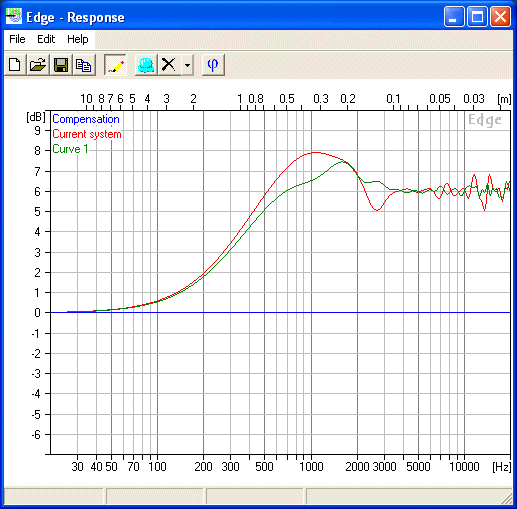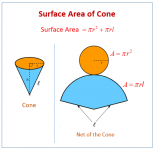I was searching for baffle step calculator yesterday, and I found one that had 380/baffle width (in feet) = baffle step frequency. Of course that means that at 1 foot (12 inches) the baffle step would be 380. But when I go to the sound frequency calculator and input 12 inches, it yields 1126 hertz. I just want to get clarity on baffle step calculation. I am putting together a system for my garage/shop.
For me your first calcul is the formula i use which proved to be effective in practice, but i can't explain the theory behind it.
Here is a link which explain diffraction and give same formula:
True Audio TechTopics: Diffraction Loss
Here is a link which explain diffraction and give same formula:
True Audio TechTopics: Diffraction Loss
I'm a bit uncertain about that link, given that it refers to diffraction as a loss (and also talks about it in terms of gain).
1126Hz is where 12" is a wavelength, rather than where the baffle is losing half space support.
1126Hz is where 12" is a wavelength, rather than where the baffle is losing half space support.
Maybe you are right Allen i don't know.
As i said i don't get how this rule of thumb works but in practice it does from my experience.
I agree with your point about the loss. I've always thought about it being a difference in directivity behavior rather than a gain or a loss. The fact it is minimum phase and can be corrected by an eq is nice but not the cause of what is observed.
As i said i don't get how this rule of thumb works but in practice it does from my experience.
I agree with your point about the loss. I've always thought about it being a difference in directivity behavior rather than a gain or a loss. The fact it is minimum phase and can be corrected by an eq is nice but not the cause of what is observed.
Hi,
A little off topic, but ?
About calculators, may someone please tell how the driver should be chosen in The Edge soft from Tolvan please ?
For illustration when one is choosing a 10 cm diameter, is it the surface of the cone or is the 10 cm the whole driver diameter and then the Sd radiating is an abstract of the full sized driver ?
A little off topic, but ?
About calculators, may someone please tell how the driver should be chosen in The Edge soft from Tolvan please ?
For illustration when one is choosing a 10 cm diameter, is it the surface of the cone or is the 10 cm the whole driver diameter and then the Sd radiating is an abstract of the full sized driver ?
Perhaps this baffle step compensation circuit calculator would be useful to you, rb132333.
Loudspeaker Diffraction Loss and Baffle Step Compensation Circuits
Loudspeaker Diffraction Loss and Baffle Step Compensation Circuits
Helli Gallu,
You meant in Edge the sriver sizr selection is in Sd ? That is wha I would like to know...
You meant in Edge the sriver sizr selection is in Sd ? That is wha I would like to know...
In the Edge Baffle Designer, the speaker size is entered in mm - so 'size' must mean 'diameter'.
If 'size' meant 'cone area' (Sd), it would be entered in square mm (mm squared).
Tolvan Data
If 'size' meant 'cone area' (Sd), it would be entered in square mm (mm squared).
Tolvan Data
I have a doubt now as seing the speaker shape... it will makes sense at the end the size is meant for Sd (or at least middle of the suround diameter for a full radiating area !!!!
ANyway don't want to puzzle Tolvan and drop a mail to know, that 's enough wonderfull enough to have such free tools. I will mix the results with some other softs as Jeff Bagby's and so on 🙂
(I'm making a rapid casual 3 ways o the cheap side but the mid have already which is a ScanSpeak 10F8424G00.... bafle step and difraction are a mess 🙁... and more for the tweeter in the sim I ran than the mid 🙄)
Thanks Gallu
.
ANyway don't want to puzzle Tolvan and drop a mail to know, that 's enough wonderfull enough to have such free tools. I will mix the results with some other softs as Jeff Bagby's and so on 🙂
(I'm making a rapid casual 3 ways o the cheap side but the mid have already which is a ScanSpeak 10F8424G00.... bafle step and difraction are a mess 🙁... and more for the tweeter in the sim I ran than the mid 🙄)
Thanks Gallu
.
I wouldn't agonise over the exact diameter of the driver.
P.S. You seem to be confusing radiating area (mm^2) with diameter (mm) - they are two different things.
The surface area (A) of a cone is related to the radius (r) of the cone & the length (l) of the slanting side of the cone by the equation A = πrl (A = pi x r x l).
This is the blue area shown on the right hand side of the attachment.
Sorry for the maths lesson, but hope it is helpful! 🙂
P.S. You seem to be confusing radiating area (mm^2) with diameter (mm) - they are two different things.
The surface area (A) of a cone is related to the radius (r) of the cone & the length (l) of the slanting side of the cone by the equation A = πrl (A = pi x r x l).
This is the blue area shown on the right hand side of the attachment.
Sorry for the maths lesson, but hope it is helpful! 🙂
Attachments
Last edited:
I was searching for baffle step calculator yesterday, and I found one that had 380/baffle width (in feet) = baffle step frequency. Of course that means that at 1 foot (12 inches) the baffle step would be 380.
This sounds correct to me. The frequency that is being calculated is, I believe, the midpoint (on a log frequency scale) of the baffle step for a sphere of that diameter. The problem is, you loudspeaker enclosure is probably not a sphere and this will change the shape of the baffle step, especially at the top end.
If you want a little more detailed picture of the frequency response effects that a driver will have when placed in a baffle, I strongly suggest that you download and use the Edge. This lets you set the baffle size and shape, and place a driver of a given size. You can then move a hypothetical "mic" around and see how the baffle step changes with position. It's a great tool for exploring what-if scenarios, and much better than that ancient equation you are using!
The only thing that one should keep in mind is that the program does not include the driver's own output, only the frequency response changes brought on by the baffle itself. You will have to add that to the driver's in-box (nearfield or infinite baffle) response to get its overall output as you would measure it in the real world by a microphone.
You can find The Edge here:
Tolvan Data - The Edge
You get plots like this:


@ Galu, thanks for the picture it's easier than the maths while you can agonize todays with pictures 🙁 !
Nah, I'm aware of the Sd definition but I just assumed it was a plan surface in The Edge, that's all ! What confuse me is often people says a 8" speaker whil the diameter of the emitting surface is 6.5" for instance (ok, with a Sd of around 11x to 13x mm2 Sd according the model and cone shape and mushrooms season 😀).... so just wanted to know which of the two o choose in The Edge when you draw the driver on the bafle !
But perhaps the question was an overkill one... But if I take the ScanSpeak 10F again : driver diameter is 10 cm while the emiting surface diameter is around 6.5 cm diameter took from the midle of the suround ... and it changes the result totally ! Well, I am going to a rtfm of the Edge evening 😱😴😛
Nah, I'm aware of the Sd definition but I just assumed it was a plan surface in The Edge, that's all ! What confuse me is often people says a 8" speaker whil the diameter of the emitting surface is 6.5" for instance (ok, with a Sd of around 11x to 13x mm2 Sd according the model and cone shape and mushrooms season 😀).... so just wanted to know which of the two o choose in The Edge when you draw the driver on the bafle !
But perhaps the question was an overkill one... But if I take the ScanSpeak 10F again : driver diameter is 10 cm while the emiting surface diameter is around 6.5 cm diameter took from the midle of the suround ... and it changes the result totally ! Well, I am going to a rtfm of the Edge evening 😱😴😛
Measuring from centre of surround on one side to centre of surround on the opposite side is certainly how I would estimate the effective diameter of a driver.
Please let us know if you get any clarification from the Edge.
P.S. Sorry, again, for the lecture!
Please let us know if you get any clarification from the Edge.
P.S. Sorry, again, for the lecture!
Horn designers use it too. It's based on directivity control.equation
- Home
- Loudspeakers
- Multi-Way
- Clarification on Baffle Step Calculation
